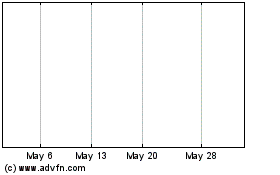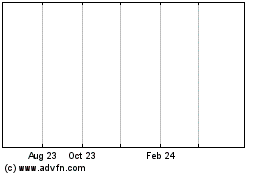Introducing Laser Corneal Transplantation - the Procedure's Greatest Advancement in 50 Years - With IntraLase-Enabled Keratoplas
October 26 2006 - 9:00AM
PR Newswire (US)
The IntraLase FS Laser Revolutionizes the Sight-Saving Procedure of
Last Resort for Patients; Potentially Offers Better Safety and
Visual Outcomes, and Faster Healing IRVINE, Calif., Oct. 26
/PRNewswire-FirstCall/ -- IntraLase(R) Corp. (NASDAQ:ILSE) today
announced the worldwide launch of its IntraLase-Enabled
Keratoplasty(TM) (IEK(TM)) technology, using the company's
proprietary femtosecond laser to potentially make corneal
transplant surgery safer, with faster healing and better visual
results, for patients suffering from severe corneal disease or
damage. For the first time, patients around the globe will be able
to choose the laser technology that represents the greatest
advancement in the procedure in more than 50 years. To view the
Multimedia News Release, go to:
http://www.prnewswire.com/mnr/intralase/25939/ Many of the world's
leading ophthalmic institutes have begun using the upgraded
IntraLase FS laser, designed for use during corneal
transplantation, including the University of California, Irvine,
Corneal Research Foundation and the Bascom Palmer Eye Institute in
the U.S. as well as the Munich Cornea Bank and the Cornea and
Refractive Surgery Department at Universidad Nacional Autonoma de
Mexico. The first laser in the U.S. used to create incisions for
corneal transplantation, the IntraLase FS laser allows the surgeon
to create complex, shaped incisions that allow the recipient and
transplant tissue to fit together much like an intricate puzzle.
The result is a potentially stronger graft that may require fewer
sutures with patients reporting faster healing and visual recovery.
"With the excellent safety and visual results achieved with IEK,
corneal transplantation now becomes a more accessible and
successful treatment option for both surgeons and their patients,"
said Robert J. Palmisano, president and CEO of IntraLase. "By
advancing corneal transplants in the course of treatment, our
technology may increase corneal transplant procedure volume over
the next few years." Data collected from 23 initial
IntraLase-Enabled Keratoplasty cases demonstrate significant
improvement in vision over the traditional trephine approach: * At
three months post-op, 45 percent of IEK patients report visual
outcomes of 20/40 or better vision -- qualifying them to drive
without corrective lenses. * In contrast, a large-scale clinical
study of trephine-initiated corneal transplantations showed only 30
percent of more than 2,200 patients achieved similar visual
outcomes.(1) * Furthermore, 91 percent of IEK cases report a best
corrected visual acuity of 20/80 or better at 3 months compared to
58 percent of trephine-initiated cases. "This preliminary data
shows that in just one year since the very first cases were
completed, the IEK technology is making tremendous improvements in
a procedure that we have been performing and developing for more
than half a century," said William Culbertson, M.D. director of the
Bascom Palmer Eye Institute and professor of ophthalmology at the
University of Miami. "It is impressive that our early IEK cases
compare so favorably against a study of 2,200 of the best
trephine-initiated cases. I believe even greater results with IEK
are on the horizon as we all continue to advance our technique."
With the announcement of the first IEK corneal transplant cases in
January 2006, surgeons at several leading U.S. ophthalmic centers
have now used the IntraLase(R) FS laser to make incisions in more
than 100 successful corneal transplant surgeries. IntraLase
received U.S. Food and Drug Administration clearance for the
laser's use in penetrating keratoplasty procedures in September
2005. The IntraLase FS laser is the first femtosecond laser cleared
in the U.S. for use in a variety of corneal and refractive
procedures, including creating the corneal flap for LASIK surgery.
The ultra-fast laser, now in its 4th generation, pulses at 60,000
kHz to give surgeons the power and precision (+/- 10 microns) to
create corneal incisions that, for the first time, can be
customized to the individual patient's condition. Laser Replaces
Traditional Trephine "Cookie Cutter" Before the advent of the IEK
technology, corneal transplants were traditionally performed using
a handheld, bladed "cookie cutter" called a trephine that is
stamped onto the cornea to make a circular incision with straight,
vertical edges. The remaining corneal bed is cut and lifted with a
scalpel, resulting in a simple, plug-shaped tissue graft. With
trephine preparation, the transplanted tissue graft requires
suturing around the circumference of the corneal graft as well as
spot sutures to maintain its position. Sutures stay in the eye for
one year or longer, and patients generally do not achieve full
visual recovery for at least a year, due to increased astigmatism.
Patients Benefit From Laser's Safety, Precision and Effectiveness
Instead of the straight vertical cut performed in
trephine-initiated corneal transplantation, the IntraLase FS laser
is programmed by the surgeon, using IntraLase's patented computer
interface, to create precisely shaped incisions in both the
patient's diseased cornea and the transplant tissue. Then, the
laser's infrared light beam is precisely focused to a point within
the cornea where microscopic bubbles are formed to establish the
incision. The laser is able to create complex incisions such as the
"top hat," "zigzag" and "mushroom" that are nearly impossible for
the manual, handheld trephine. The preliminary clinical work with
IEK demonstrates that by creating incision edges that fit together
in an interlocking design, the graft is more stable and, therefore,
may heal faster.(2) Some important advantages imparted by IEK may
address patient comfort and visual functionality: * Fewer and/or
looser sutures are needed to keep the IEK incised graft in
place.(2) * Sutures are removed much earlier; before six months in
initial cases versus one year or longer with traditional
trephine-initiated keratoplasty.(3) * Patients achieve their full
vision faster -- many are able to return to work one month
post-op.(2) * The risk for displacement of the graft is
significantly reduced as shaped incisions have demonstrated a
seven-fold increase in strength.(2) "The precision of the IntraLase
FS laser makes it possible to create advanced edge profiles that
optimizes the wound architecture which can lead to significantly
improved outcomes over trephine-initiated procedures," said Roger
F. Steinert, M.D., director of cornea, refractive and cataract
surgery at the University of California, Irvine and immediate
past-president of the American Society of Cataract and Refractive
Surgery. "This technology represents an unprecedented advance in
cornea transplantation and clearly demonstrates that the IntraLase
femtosecond laser is rapidly moving us toward a revolution in
corneal surgery." IEK-Harvested Donor Tissue = Completely
Customized Corneal Transplant Several of the world's leading eye
banks are using the IntraLase FS laser to prepare corneal tissue
used for transplantation including the Northwest Lion's Eye Bank
and Tissue Banks International. Surgeons can order customized
tissue from either of these eye banks, prepared with specific edge
profiles to meet the needs of their patients. During the transplant
procedure, the surgeon uses the IntraLase FS laser to make the same
shaped incision in the patient to remove the patient's diseased or
damaged corneal tissue. Uniquely shaped edge profiles on patient
tissue allows for a customized fit to the laser-prepared donor
graft provided by the eye bank. About Corneal Transplantation
Corneal transplantation has restored sight to thousands who
otherwise would be blind due to corneal injury, infection, or
inherited corneal disease or degeneration. Corneal transplantation
replaces a diseased or scarred cornea with a new one by having the
central portion of the cornea surgically removed and replaced with
corneal tissue donated through an eye bank. In 2005 more than
105,000 corneal transplants were performed annually worldwide,
according to EEBA 2005 Annual Statistics. About IntraLase Corp.
IntraLase designs, develops, and manufactures an ultra-fast laser
that is revolutionizing refractive and corneal surgery by creating
safe and more precise corneal incisions. Delivering on the promise
of ophthalmic laser technology, the IntraLase FS laser, related
software, and disposable devices replace the hand-held
microkeratome blade used during LASIK surgery. The unsurpassed
accuracy of IntraLase's computer-controlled femtosecond laser has
been shown to improve safety profiles and visual outcomes when used
during LASIK. Additionally, the IntraLase FS laser creates
precision-designed intracorneal incisions that when combined can be
used during lamellar and penetrating keratoplasty, and intrastromal
ring implantation. IntraLase is presently in the process of
commercializing applications of its technology in the treatment of
corneal diseases that require corneal transplant surgery. The
company's proprietary laser and disposable patient interfaces are
presently marketed throughout the United States and 32 other
countries. IntraLase is headquartered and manufactures its products
in Irvine, California. For additional information, visit the
company's web site: http://www.intralase.com/. Forward-Looking
Statement Statements contained in this press release that are not
historical information are forward-looking statements as defined
within the Private Securities Litigation Reform Act of 1995.
Forward-looking statements can be identified by the use of words
such as "believe," "expect," "anticipate," "intend," "plan,"
"estimate," "project," or words of similar meaning, or future or
conditional verbs such as "will," "would," "should," "could," or
"may." Such forward-looking statements are subject to risks and
uncertainties that could cause actual results to differ materially
from those projected or implied. Those risks and uncertainties
include, but are not limited to: the degree of continued acceptance
of LASIK surgery; potential complications revealed by long-term
follow up; the extent of adoption of our product offering by LASIK
surgeons; general economic conditions; changes in federal tax laws
governing the ability of potential LASIK patients to use pre-tax
dollars to pay for LASIK surgery; the scope of government
regulation applicable to our products; patients' willingness to pay
for LASIK surgery; our ability to compete against our competitors;
the effectiveness of our measures to ensure full payment of
procedure fees; the occurrence and outcome of product liability
suits against us; our ability to adequately protect our
intellectual property; whether we become subject to claims of
infringement or misappropriation of the intellectual property
rights of others; the continued availability of supplies from
single-source suppliers and manufacturers of our key laser
components; the ability of our managers, operations, and facilities
to manage our growth; the success of our expansion into markets
outside the United States; whether we lose any of our key
executives or fail to attract qualified personnel; or if our new
products or applications fail to become commercially viable.
Certain of these risks and uncertainties, in addition to other
risks, are more fully described in the company's quarterly report
on Form 10-Q for the period ending June 30, 2006, as filed with the
Securities and Exchange Commission on August 1, 2006. These
forward-looking statements are made only as of the date of this
press release, and the company assumes no obligation to update or
revise the forward-looking statements, whether as a result of new
information, future events, or otherwise. 1. "Conclusions of the
Corneal Transplant Follow Up Study," A Vail, SM Gore, B A Bradley,
D L Easty, C A Rogers and W J Armitage. British Journal of
Ophthalmology, 1997. 2. Personal communication with Roger F.
Steinert, M.D. 3. Personal communication with Francis W. Price,
M.D. http://www.prnewswire.com/mnr/intralase/25939DATASOURCE:
IntraLase Corp. CONTACT: Liana Miller, +1-949-276-8920, , for
IntraLase Corp. Web site: http://www.intralase.com/
Copyright
Intralase (NASDAQ:ILSE)
Historical Stock Chart
From Apr 2024 to May 2024

Intralase (NASDAQ:ILSE)
Historical Stock Chart
From May 2023 to May 2024
